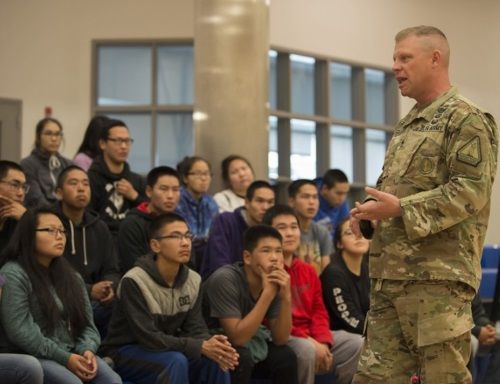Military Recruitment in Schools

March 14, 2022
Since the advent of humankind and warfare, the military need for manpower has been (and continues to be) one of the most pressing concerns of armies across the globe. Furthermore, there exists a solution almost equally as old as the problem itself: the recruitment of adolescents, burgeoning adults, and developing youths as a whole. In the United States, military recruitment of students is a federally sanctioned practice that exists within our education system. However, in the modern “Age of Peace” the morality and need for this age-old practice is being called into question in a greater wave of anti-militarism and progressivism across the United States.
As with many other legal uncertainties in the nation, military recruitment existed in the “in-between” of U.S. law, with the practice being neither affirmed nor prohibited universally. This, however, changed with the U.S.’s introduction into the First World War. The conflict emphasized the need to field a larger army to compete with the Central Powers, and so under President Woodrow Wilson the Selective Service Act of 1917 was passed. Thus, the race for manpower began. In the next World War, the American education system suffered debilitating losses on multiple fronts. Funding was redirected, teaching staff were conscripted or compelled to volunteer, and most importantly, the dropout rate skyrocketed as students left to join the war effort. During the conflict, enrollment in high school dropped by a score of 1.2 million students. Later, during the Vietnam War, the draft sent education into a similar tumult. With “The Draft” becoming a hot issue, the widely-progressive student body of the U.S. fought against military presence on their campuses.
The end of U.S. involvement in the Vietnam War marked the opening up of debate over military recruitment in schools. Educational institutions provided the perfect environment for recruitment because of two main factors. First is accessibility: the school environment enables recruiters to reach a large audience of potential candidates five days a week. Second is career relevancy: the military is a legitimate pathway for many students, offering a wide range of opportunities in which to invest. When the bells of war tolled once more, the need for recruits increased. During , the federal government stepped in to settle the (legal) debate once and for all. In 1996, the Solomon Amendment signaled the federal government’s “writing of a blank-check” to the military. The amendment, in summary, authorized the Secretary of Defense to withhold federal grants to educational institutions should they refuse to accommodate military recruiters and their programs. Most decisive was the No Child Left Behind Act of 2001, in which a clause dictated that all public schools must provide students’ information to military recruiters with parental consent.
The twenty-first century saw the United States develop into a more reformist society. With progressivism came the inevitable pushback against the military’s involvement in schools. Many recruitment practices were called into question. For example, the divulgence of student information faced widespread criticism regarding how parental consent was gained. Most schools used the “Opt-out” approach; this meant parents had to choose not to share information with recruiters. The lack of awareness of this practice meant that many parents unwittingly had their students’ school information shared with military recruiters. Furthermore, the lower-class minority groups targeted by recruiters caused many to see the military as predatory upon more disadvantaged communities and individuals.
One of the largest criticisms of military recruitment revolves around the dishonesty of recruiters about conditions and opportunities within the military. Some groups, such as the National Network Opposing the Militarization of Youths, claim that recruitment practices normalize violence and the concept of warfare. To these advocates, this normalization qualifies as an attempt to militarize an exploitable age group; as such, special measures must be taken to protect students from predatory practices.

